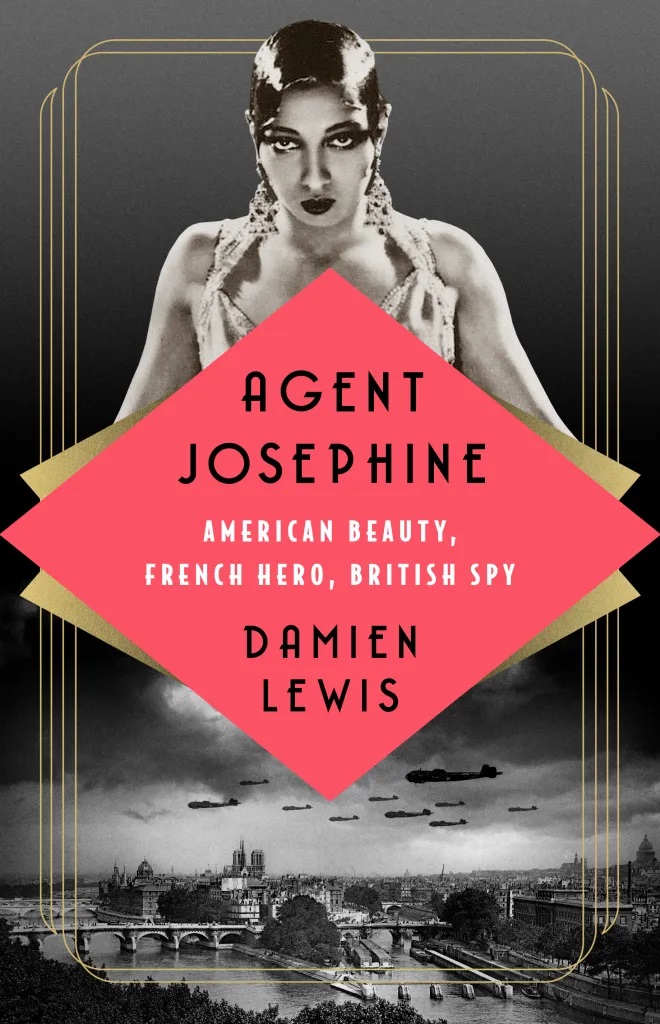“It seemed the perfect way to fight my war.”– Josephine Baker
No American was ever more beloved by the French nation than Josephine Baker. In France’s hour of greatest peril she risked everything returning that love. Using her fame for cover during the Second World War she spied on the Axis for the French Resistance and Allies.
Baker’s heroism is now fully documented in a thrilling narrative.
 Her patriotism was formally recognized in 2021 when she was interred in the French Pantheon. It’s the highest honor that can be conferred on a citizen of France. Only the sixth woman, Baker joined an elite echelon of some 100 national heroes, including writers and philosophers Voltaire and Rousseau, physicist Marie Curie, novelists Victor Hugo and Alexandre Dumas.
Her patriotism was formally recognized in 2021 when she was interred in the French Pantheon. It’s the highest honor that can be conferred on a citizen of France. Only the sixth woman, Baker joined an elite echelon of some 100 national heroes, including writers and philosophers Voltaire and Rousseau, physicist Marie Curie, novelists Victor Hugo and Alexandre Dumas.
Damien Lewis is the media-savvy British author of some twenty WWII histories and novels. Agent Josephine has been adapted for a French mini-series and the recent theatrical movie “Ministry of Ungentlemanly Warfare” is based on his book by that title. His professional background is in journalism including award-winning documentaries on North Africa. In interviews he often expresses awe at her “core of steely fortitude, an unbreakable spirit that was hard wired into her soul . . . it is more incredible than I ever imagined . . . defined by raw courage, maverick daring, double- and triple-bluff and fabulous chutzpah.”
This is not a general biography of Josephine Baker. Her life is well chronicled elsewhere. Nonetheless, Lewis probes her youth in St. Louis and Paris years for clues to her character and motivations.
“J’ai Deux Amours,” Pathe film of Josephine Baker, Paris, 1933:
Josephine at War
By 1940 Baker was wealthy, famous and influential. But she didn’t accommodate the new Reich nor flee to safety as did some French entertainers. Instead, she acted defiantly despite dire threats of severe retribution promised for anyone caught spying against Germany in occupied France, climaxing in execution by guillotine – face up.
To cover for her espionage Josephine leveraged her status as an international superstar. Socializing with the enemy in Vichy-France, Spain, Portugal and Morocco she gleaned prized intelligence about the strategic capabilities and intent of the Axis powers. At the same time, she entertained thousands of troops, gave away her fortune comforting the poor and displaced and her personal interventions saved untold numbers of Jewish refugees.
She found respite in Marrakesh, Morocco sheltering under the avuncular patronage of Thami El Glaoui, Pasha of Marrakesh, a powerful Berber chieftain. He was, reports Lewis (p. 195):
. . . shrewd, worldly wise, cultured and highly educated – he had studied in widely in Paris. Lean, hawk-faced, dark eyed, he was reputed to keep a harem of 365 women. While . . . he could prove fabulously generous and attentive, he was in effect a medieval lord whose home was served by scores of slaves. In time El Glaoui would ‘adopt’ Josephine and her mission wholeheartedly.
Fellow warriors, charismatic visionaries, charmers and survivors, the Berber chief and Josephine-the-superstar hit it off, and via their shared strength of character would forge a special bond.
In North Africa, she asserted a pivotal yet off-the-books diplomatic role solidifying the anti-Fascist military alliance gathering to confront German forces. Her role in the war, he writes, was “acting as the glue that held together the coalition of the willing in North Africa – Berber leaders, Rif chieftains, Arab dignitaries, American troops both black and white, (former) Vichyites, plus the Free French forces now mustering.” Taking further risks she followed “Operation Torch” in late 1942 on her own initiative, cheering and entertaining the multi-national armies.
BBC short documentary:
The Queen of Paris
Briefly recapping her story, Josephine Baker set European audiences aflame dancing in Paris and Berlin in 1925, ’26 and ’27, triggering a continental fascination with African music and culture, redirecting the path of Continental music, art and fashion. An untrained dancer she devised an original comedic style once described as “artful clumsiness.” Her biggest musical hit was the song “J’ai Deux Amor.” Recorded in 1931, it was a personal anthem signifying her incompatible desires — “I have two loves, my country and Paris” — divided between Jim Crow America and the City of Lights where she was queen.
Josephine was not a Jazz vocalist. This assertion might surprise or upset some, but it’s a description not a value judgement. There are almost no Jazz or Blues characteristics in her singing. Baker is excluded from the foremost histories of American women in jazz written by Sally Placksin and Linda Dahl. She is not included in the Grove Dictionary of Jazz, nor in the landmark jazz discography of Brian Rust who reasons that her records “do not offer anything likely to interest the jazz collector.”
Josephine takes Paris:
Rather, Baker was a completely original artist beyond category. She created her own innovative personal style from updated music hall, cabaret and theatrical traditions fused with her rich imagination. For instance, among her major triumphs of 1934-35 was a modern revival of the Jacques Offenbach opera “La Creole” in the same Parisian theater where the composer had premièred it in 1875. Nevertheless, she often hired brilliant African American jazz musicians for her glittering extravaganzas and international tours such as trombonist Herb Fleming and horn master Arthur Briggs. (Briggs survived the war in mild internment at a POW camp near Paris.)
Lewis describes Josephine’s horrifying late-1920s tour of Germany. Her formerly receptive Teutonic fans had turned hostile and Nazi propagandist Joseph Goebbels condemned her as the personification of “degenerate” culture. German audiences hooted and catcalled. Leaflets denounced her “brazen-faced heathen dances” marking Baker a “Jezebel” and “Black Devil.” Nationalists and Nazis demonstrated. Banned outright in Munich, she was “haunted, harangued, abused and forced to flee,” he writes. “After the shock of that tour, Josephine kept her distance from Germany.”
This spirited Youtube video, “Josephine Baker’s Double Life,” is slightly marred by minor errors, such as confusing “access” with “axis” and “incandescent” with “clandestine.”
Agent Baker
To maintain her elaborate cover as an international touring entertainer (and her income), Baker was obliged in 1940 to stage “La Creole” in Marseilles. She successfully reprised her comic-opera debut, recreating the Parisian décor and costumes for a short run in late December 1940 into mid-January, before fleeing to Morocco.
Adding intrigue to the tale is a love affair with her espionage liaison officer, Jacques Abtey. (She had a talent for converting former lovers into lifelong friends and allies.) Meanwhile, Josephine maintained for as long as possible her effervescent menagerie of pets: a monkey, mice, a Great Dane and her famed panther Chiquita.
The first one-third of the book is a fulsome account of the emergent spy network in which Baker was ensconced. Some readers might find tedious the catalog of diplomatic subterfuges, arms dealing, state sponsored criminal enterprises (smuggling cigarettes was lucrative), sabotage, subterfuge, secret radio transmissions, assassinations and guerilla attacks of the new spy craft.
This is part of a larger story of the (General de Gaulle-aligned) French Resistance and counter-espionage initiative of WWII which could not be told in full without accounting for Baker’s crucial role. Lewis deftly sketches profiles of the rogues, eccentrics and operatives orbiting her, stressing the extreme danger of the circumstances.
During nearly a decade of investigations, the author researched formerly-secret military archives, memoirs, correspondence, personal accounts and was granted rare access to the personal archives of key British spymaster, Commander Wilfred “Biffy” Dunderdale. The narrative is richly informed by his masterful fluency in the “ungentlemanly warfare” of WWII. This voluminous research is meant to stand as durable, authoritative proof of her contributions to winning the war.
Josephine’s stuff went right to the top, yet not even Churchill knew the source. In interviews, Lewis stresses the stupendous risks that she and her associates took. For instance, absconding from France to Portugal in 1940 she was smuggling documents of strategic value:
Traveling with all her tour trunks stuffed full of this war winning intelligence . . . pictures of invasion craft, details of the German air bases, the lists of German agents inserted into Britain. . . . that journey across borders, through checkpoints which she pulls off because everywhere in her furs and her jewels she glitters as a star and everyone is star struck and no one can conceive she might be actually spiriting through war-winning intelligence.
Josephine sings for Allied troops, probably 1944 in or near Paris:
Reconciling Deux Amours
After the 1944 liberation of Paris, Josephine persisted in her crusade as she tagged closely behind the multi-national forces advancing on Germany. Singing “J’ai Deux Amours” for Allied troops she was luminous, having honed her extraordinary gift for gathering and focusing an audience into a patriotic weapon. The anthem had formerly denoted her divided world now united in common cause, reconciling the irreconcilable.
Her wartime performances culminated with a 30-foot flag of Free France unfurling behind her on stage. No mere partisan foe of Fascism, she was transcendent, become an avatar of liberation: racial, artistic, national, international and feminist. Her 1975 funeral was nothing short of a state affair in France; twenty thousand mourners clogged the streets of Paris. In a Catholic memorial she received full military honors.
Josephine Baker’s 2021 interment to the French Pantheon is her zenith. She is the first performing artist, the first Black woman and the first American thus honored, symbolically re-interred with vials of soil placed in her crypt from the three nations she had called home: France, USA and Monaco.
Only now can the soaring arc of her saga be seen in its full historic, cinematic and heroic dimensions. I commend and recommend this stirring narrative, which I enjoyed in the audiobook format read by the author.
Agent Josephine: American Beauty, French Hero, British Spy
by Damien Lewis
Hardcover: ISBN-9781541700666; 496 pp., $32
Trade Paper: ISBN-9781541700673; 512 pp., $21.99
E-book: ISBN-9781541700680; 496 pp., $14.99
PublicAffairs (www.hachettebookgroup.com)
Unabridged Audio: ISBN-9781549193132; $38.99
Hachette Audio
(www.hachettebookgroup.com)
Baker to be honored at the Pantheon, Euronews report:
Bibliography:
Agent Josephine: American Beauty, French Hero, British Spy, Damien Lewis (Public Affairs/Hachette, 2022)
Josephine, Josephine Baker & Jo Bouillon (Marlow and Company, 1977)
Josephine Baker: The Icon and the Image, Bennetta Jules-Rosette (University of Illinois Press, 2007)
Josephine Baker links:
https://www.hachettebookgroup.com/titles/damien-lewis/agent-josephine
https://www.newyorker.com/josephine-baker-was-the-star-france-wanted-and-the-spy-it-needed
https://lithub.com/how-josephine-baker-learned-to-hate-the-nazis-before-most-of-america
https://joepompeo.substack.com/p/damien-lewis-on-agent-josephine
https://guides.loc.gov/feminism-french-women-history/famous/josephine-baker
https://www.jerryjazzmusician.com/a-womens-history-month-profile-josephine-baker
https://www.pbs.org/josephine-baker-first-black-woman-honored-in-frances-pantheon
https://www.cia.gov/stories/story/josephine-baker-from-poverty-to-stardom-to-espionage
https://www.npr.org/2021/11/30/1059776777/josephine-baker-france-pantheon



























